-
Paper Information
- Paper Submission
-
Journal Information
- About This Journal
- Editorial Board
- Current Issue
- Archive
- Author Guidelines
- Contact Us
American Journal of Environmental Engineering
p-ISSN: 2166-4633 e-ISSN: 2166-465X
2015; 5(4): 120-129
doi:10.5923/j.ajee.20150504.04
The Development of Vital Precincts in Doha: Urban Regeneration and Socio-Cultural Factors
Raffaello Furlan1, Laura Faggion2
1College of Engineering, Department of Architecture and Urban Planning, Qatar University, Doha, State of Qatar
2School of Urban and Environmental Planning, Griffith University, Brisbane, Australia
Correspondence to: Raffaello Furlan, College of Engineering, Department of Architecture and Urban Planning, Qatar University, Doha, State of Qatar.
| Email: |  |
Copyright © 2015 Scientific & Academic Publishing. All Rights Reserved.
Through the past few decades, Doha, the capital of the State of Qatar, has experienced an extraordinary economic growth and transformation of its built environment. This has been caused by post-WWII oil and natural gas production, which has transformed the economy of Qatar from fishing and pearling based to a differentiated economy. The State of Qatar is currently investing large funds into the transformation of Doha’s built environment and the development of new major urban public transit networks (i.e. the Doha Metro, the Lusail light rail transit (LRT) and a bus rapid transit (BRT)). Authorities are committed to have the new transport systems operational before the 2022 FIFA World cup competition. This paper discusses the key factors and/or challenges to be studied and considered for integrating Doha metro transport system with land use. Namely it is argued that the key factors for the design and planning of successful, functional and economically vital precincts developed in the proximity of the new Doha Metro stations are related to tangible or financial-economic aspects, as well as intangible or socio-cultural aspects.
Keywords: Built Environment, Urban Fabric, Doha Metro, TODs, Tangible and Intangible factors, Livability
Cite this paper: Raffaello Furlan, Laura Faggion, The Development of Vital Precincts in Doha: Urban Regeneration and Socio-Cultural Factors, American Journal of Environmental Engineering, Vol. 5 No. 4, 2015, pp. 120-129. doi: 10.5923/j.ajee.20150504.04.
Article Outline
1. Introduction: The Urban Transformation of Doha
- Between 2000 and 2009 Qatar’s real GDP grew at an annual average of 13.1%. Over this period Qatar’s economy has grown faster than any other, and, measured in purchasing power parity terms, its per capita GDP is now among the highest in the world. Much of this expansion has occurred since 2004—from 2004 to 2009 real GDP growth averaged 17.1% a year (Qatar National Development Strategy 2011-2016). ….“During the second half of the 20th century Qatar witnessed its first modern urbanization period accompanied by rapidly increasing oil production and lucrative oil export contacts” (Salama & Wiedman, 2013, p. 61).The State of Qatar, located on a peninsula in the Arab Gulf (Figure 1-2), with a coastline of approximately 600km, is a mostly sea level and flat land. Due (1) to the 1950s profitable export of oil, (2) to the 1970s discovery of the world’s largest gas field (known as the ‘North Field’) and (3) to the 1990s production of liquefied natural gas, Qatar went through a recent and rapid urbanization process.
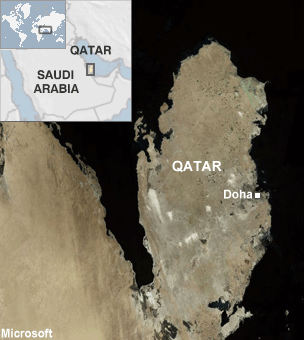 | Figure 1. Geographical Map of Qatar |
 | Figure 2. Qatar’s Municipalities |
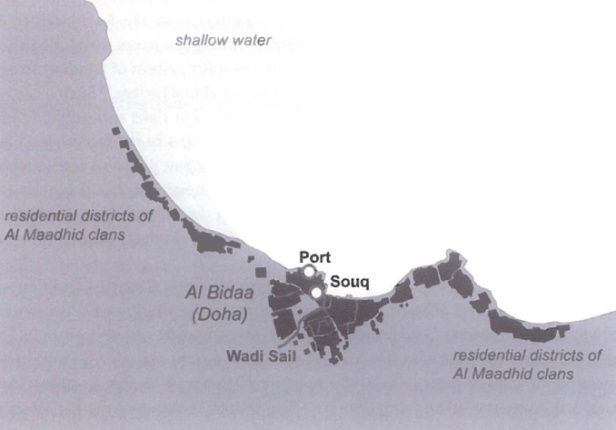 | Figure 3. Doha’s pre-oil settlements in the 1950s (Salama & Wiedman, 2013) |
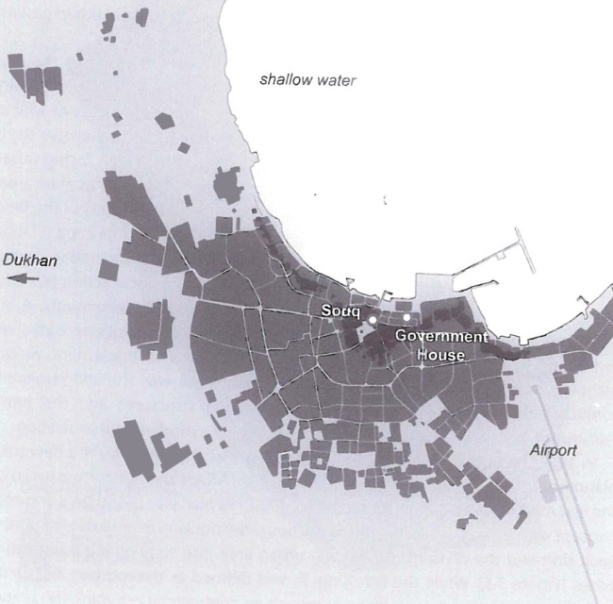 | Figure 4. Doha’s settlement areas in the 1970s (Salama & Wiedman, 2013) |
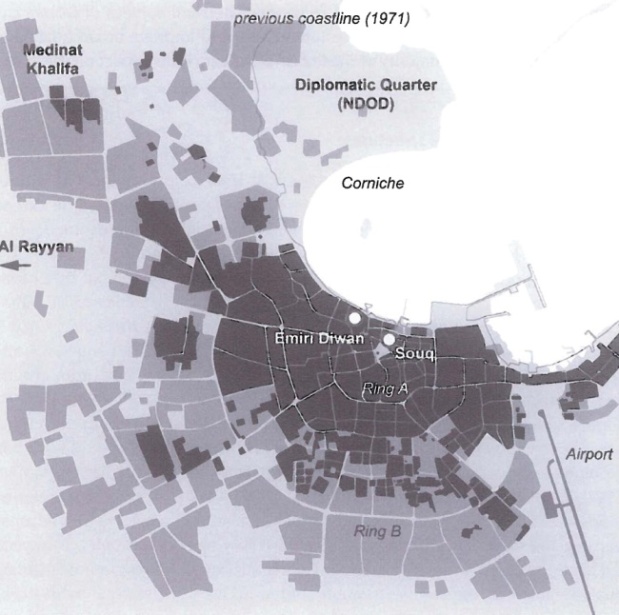 | Figure 5. The settlement areas in the 1990s (Salama & Wiedman, 2013) |
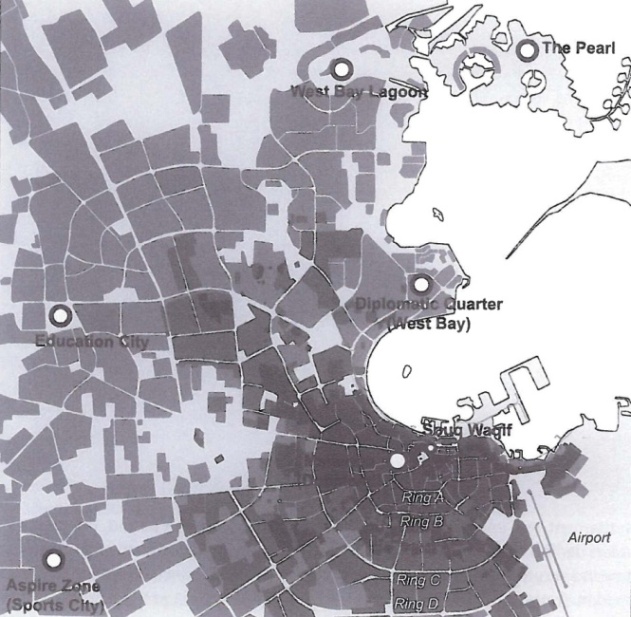 | Figure 6. The past ten years settlement expansion (Salama & Wiedman, 2013) |
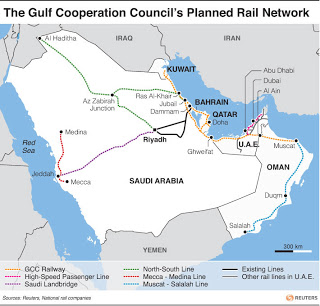 | Figure 7. The Gulf Rail Network |
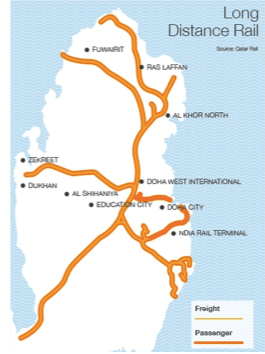 | Figure 8. Qatar Long Distance National Rail |
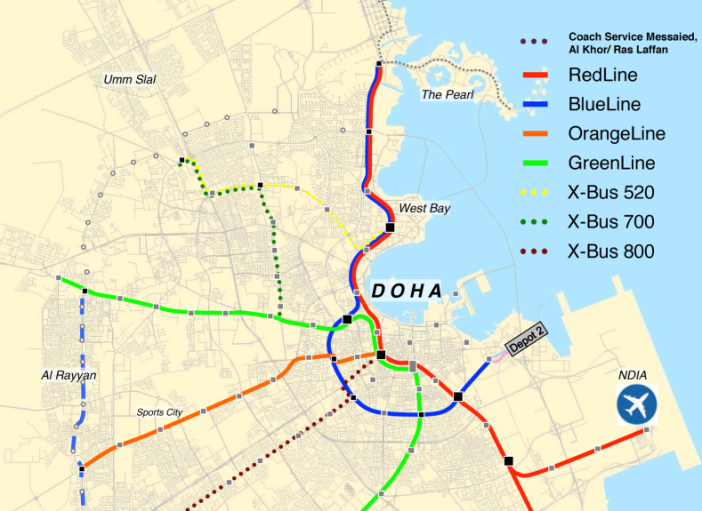 | Figure 9. Diagram of Doha Metro Network |
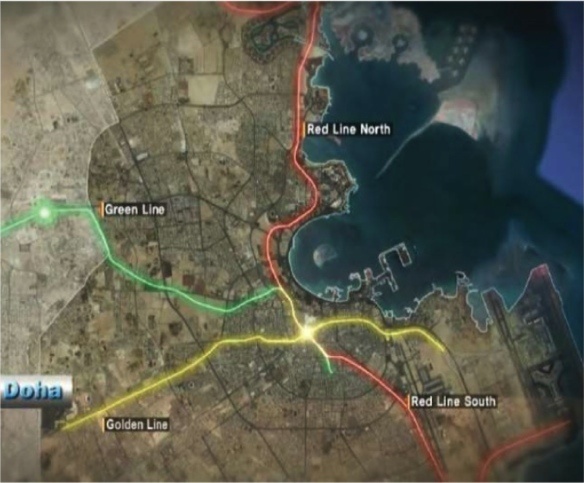 | Figure 10. Aerial view of Doha Metro Network |
 | Figure 10. Scheme of Doha Metro Network (Phase 1) |
 | Figure 11. Scheme of Doha Metro Network (Phase 2) |
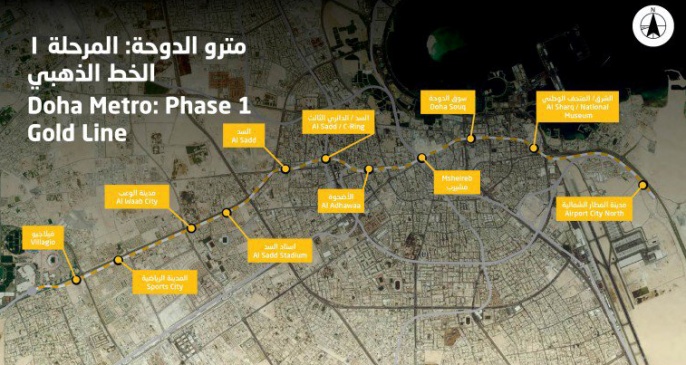 | Figure 11. The Metro Gold Line (by Qatar Rail) |
 | Figure 12. The Metro Green Line (by Qatar Rail) |
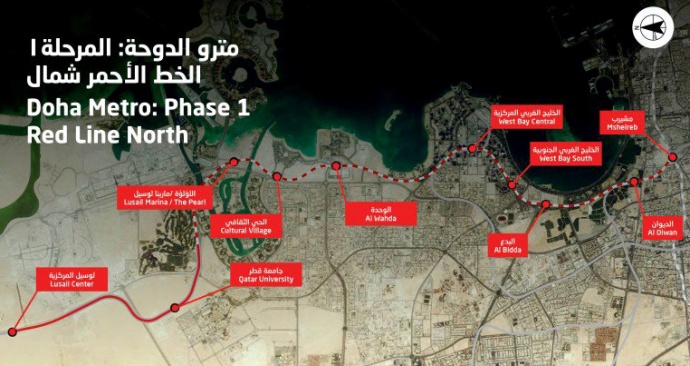 | Figure 13. The Metro Red Line North (by Qatar Rail) |
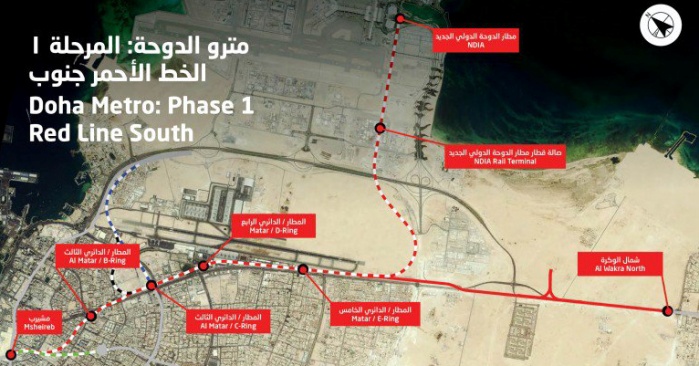 | Figure 14. The Metro Red Line South (by Qatar Rail) |
2. Background
- Transit Oriented Developments (TODs): A Strategy for Smart GrowthA transit-oriented development (TODs) is defined as a compact, walkable, mixed-use residential and commercial neighborhood. TODs are surrounded by relatively high-density, with progressively lower-density, developments, with a narrower range of land uses, such as a residential or employment district, spreading outward from the center (Arrington & Cervero, 2008).TODs are usually located near transit centers or public transport node (train, metro, tram or bus) and, therefore, designed to maximize access to public transport. TODs are located within an 800m buffer area from a transit station, as this is considered to be an appropriate scale for pedestrian. This distance corresponds to the space someone can walk in 10 minutes at 3 mph (4.8 km/h) and is a common estimate for the distance people will walk to get to a rail station. Therefore, TODs can be defined as “a mix of uses, at various densities, within a walkable radius of a transit stop” (Cervero & Kockelman, 1997; Erwing & Cervero, 2010).TOD is not just a recent phenomenon. At the beginning of the 20th century, in a period preceding the car ownership, scholars studied the relationship between the development of streetcar (or electric tram), underground and commuter railway itineraries and urban form (R. D. Knowles, 2012). From the post WWII period until the 70s, most Western European countries cities experienced rapid urban expansion, population growth due to immigration of people from rural areas to cities. This lower density suburban expansion was accelerated by the rapid rise of private car ownership (C. Knowles & Sweetman, 2004; R. D. Knowles, 2012; R.D. Knowles, 2006).Scholars and practitioners argue that TODs can maximize access to public transportation, work places, educational institutions, and other varies opportunities and facilities by promoting transportation options to households. As a result, this produces an increased transit ridership, encourages a safe and pleasant pedestrian environment near transit stations, limits clashes between vehicles and pedestrians and finally reduced road and traffic congestion. TODs contributes to reduce urban sprawls and parking requirements by encouraging shared parking and alternative means of transportation. In addition, it is argued that TODs make neighborhoods more livable because a sense of activity and liveliness is encouraged (Besser & Dannenberg, 2005; Venner & Ecola, 2007).In addition, scholars stress that this type of combined strategies contribute to improve sustainable growth (Galeo, Ribeiro, & Martinez, 2014). TOD, which is a planning technique that aims to reduce sprawl and private motorized transport (Cervero, 1998, 2013; Sung & Oh, 2011), is considered to be part of a broader smart growth approach towards urban development including new urbanism (Cervero, 2013; Galeo et al., 2014; R. D. Knowles, 2012).Key-factors for the development of vital precinctsResearchers have identified four key factors, which can support and make TODs successful. The factors are the (1) demand for real estate, (2) available land for development, (3) supportive local residents, and (4) transit line efficiently connecting to jobs and facilities. (1) The literature reveal that market demand for real estate is the primary factor developers consider when determining whether to build a transit-oriented development. This factor is driven by the strength of local economies, which allow cities with strong local economies to support the construction of TODs.(2) The availability of a large space or land such as parking lots near transit stations or underutilized industrial land can also support the formation of TODs. The land can be re-utilized to accomplish multiple goals and therefore it can acquire value: usually land in proximity to TODs tends to increase in value. Namely, underutilized industrial land provides an opportunity for the construction of TODs due to the common large size of industrial land parcels and the lack of neighbors, which might oppose or limit new development. (3) Scholars argue that resident support is fundamental to the success of TODs. Namely, a high concentration of people between 18 to 34 years old tend to be more supportive of the formation of TODs than other age cohorts. Younger residents’ desire for communities close to amenities is one of the key-factors for TODS. It is shown that it is preferred a shorter commute over a larger home. The majority of this age cohort is attracted to living in communities close to public transit, with a mix of shops, restaurants, offices, a mix of housing types and a mix of incomes.(4) Transit providing an efficient access to established jobs and centers of activity are potential for TODs. It is revealed that in order to attract people to transit, transit routes need to move from residential areas to job centers as directly as possible. Specifically, the extent to which transit connects people to central business districts, institutions such as schools, facilities and existing mixed-use communities supports TODs (Cervero, 2000; Cervero & Kockelman, 1997; Cervero, Murphy, Ferrell, Goguts, & Tsai, 2004).Barriers to the development of vital precincts Vital precincts must deal with the pressure between node and place: it must balance the transportation functions of the site with issues of making the place livable. The literature reveals that in the past there has been very little development around transit stations and that development took as long as 10 years to be completed. It is showed that there are several factors, which may severely influence the outcome of these developments. As reported by scholars and practitioners, the physical factors hindering TODs are: (1) the excessive construction cost of TODs; (2) reluctance of lenders to finance TODs; (3) lengthy local-development approval processes; (4) an unsupportive local population; (5) physical features surrounding a transit station; and (6) an unattractive land for development around transit stations.(1) It is revealed that construction cost of TODs can be more expensive than for traditional, single-use developments because of the cost of mixed-use and multiple stories buildings’ structure, parking garages and infrastructure. Namely, practitioners highlight that different functions, appearance, access, and security levels of entrances and exits for different uses can be costly features in mixed-use projects. In addition, it is stressed that in TODs the specifications for the design of parking garages can easily double the cost per parking spot compared to what it is normally construct. (2) Practitioners stress that lenders can hesitate to finance the construction of TODs because transit-oriented developments are perceived as heavier and riskier investment: they require more funds for development compared to traditional developments because enclosing mixed-use buildings. Mixed-use developments can also face market challenges because each use must have sufficient market demand to make the overall project profitable. Namely, lenders might perceive these projects as risky in areas with no history or examples of TODs, since it is unknown if there is local consumer demand for TODs.(3) The length and/or discretion of the local authority approval process are challenges that can hinder TODs. Developers face more uncertainty in developing projects when TODs are not planned in accordance with the zoning code for the zone. This issue would require a zoning variance from local authorities, causing a delay in the process of TODs design and planning. When licenses for construction processes are dependent on the discretion of the local authorities, it is difficult to predict what design requirements local officials are require as conditions of approval and when projects will get approved.(4) The negative perception of the local population of transit, dense and multi use development can affect the demand for TODs. Namely, the preference of residents to independently travel in their own car rather than on public transport (“car culture”), the height of buildings within a dense development or apparent decline in quality of life caused by the increase in population, traffic, and demand for parking, can severely inhibit demand for dense communities near transit stations.(5) The proximity of highways, vast areas of vacant land, blank walls, driveway entrances, or a lack of pedestrian crossings at streets can also hinder TODs. Namely, improving the area with sidewalk and ramps to increase walkability would provide better access to the station and overall make TODs more attractive to the residents.(6) Vacant industrial parcels of land around transit stations, not supportive of high-density, mixed-use development, can also hinder TODs. This can be perceived as being harmful to residents. The area might require significant environmental clean-up before implementing it with physical-infrastructure investment, or adding sidewalks schools and parks.Towards the Design of Vital Precincts in Doha Scholars and practitioners highlighted a number of physical key-factors, whose consideration is crucial to the formation of vital precincts around train stations or TODs. In addition, they argue that there are un-physical factors related to ‘the place’ itself, its inhabitants’ culture as a way of life, its cultural traditions and heritage, which must be taken into primary consideration (Kent, 1984; Lawrence, 1997; Oliver, 2006; Rapoport, 1969, 1982, 2000; Sanders, 1997). As anticipated, Doha is witnessing a fast urban regeneration and transformation. The urban fabric of the city displays a built environment characterized by contemporary (West Bay) and vernacular-traditional forms (The Souq Waqif). Qatari citizens and political leaders are attentive to have their cultural heritage shown within the capital’s urban fabric. This might represent an example to be followed for other cities under development in the GCC. Doha’s ambition is to become the service hub, but also and more importantly the cultural hub of GCC. The launch of the metro network represents an opportunity to have a developed and transformed urban fabric of the city as vehicle of Qatari cultural heritage. Therefore, this section discusses the un-physical or intangible factors to be considered for the development of vital precincts in Doha. Globalization, Real Estate Development and livabilityRichard Rogers and David Gumuchdjjan (1996) argue that architecture and urban design nowadays often ignore its primordial roots that are based on socio-cultural and traditional forces. They stress that with so much consideration of standards, regulations and accountability, along with the pressures inherent in the property market, whose final goal is to simply minimize building costs and maximize profit, contemporary practitioners neglect to design built environments that respond to users’ culture and traditions (1996). In addition researchers stress that globalization is currently leading to the uniform development of cities under a pure real estate strategy. This phenomenon have destabilized the physical environment of traditional Islamic cities, where buildings are often built under the interest of large western corporates (Kazimee, 2012). Under this tendency, property has become the new primarily consumer good and real estate development is the new strategy for development in Middle East, where cities are attracting and competing for international investments, business and tourism. The circulation of global capital invested for large scale developments investments, combined with excessive privatization and speculative strategies, has transformed the form of cities and changed the nature of social life. The city of Dubai in the United Arab Emirates represented a model to follow for other large cities in GCC (Daher, 2010). The new districts of Media City, Internet City or Academic City features a combination of housing units, high-rise commercial buildings, tourism developments and recreational facilities such as golf courses, shopping centres and hotels (Daher, 2010). Also, Dubai has erected the tallest skyscraper in the world, the 800m high Burj Khalifa. Dubai’s urban growth based on numerous large-scale projects has launched a trend, which other Gulf cities are tempted to follow, where vertical buildings are a manifestation of modernity and power (Mahgoub & Al-Omaim, 2010). As highlighted by Amos Rapoport, grand-elite or iconic buildings might have a strong meaning but often they are just sculptures not integrated within the urban context, which, on the other hand, is the reflection of culture, space and time (Kaspirin, 2011, p. 8). Built forms should contribute to shape settlements in response to inhabitants’ socio-cultural needs. In addition, built forms should be integrated within the built environment in order to express the interaction between inhabitants and their environment, which gives an identity to the place (Bonnemaison, 2005). Places shaped with this framework can be vehicle for livability (Brown, Dixon, & Gillham, 2014; Carmona, Tiesdell, Heath, & Oc, 2010; Cervero, 2000; Farr, 2008; Givoni, 1989; Lang, 2005). This means that the contemporary role of the urban designer is to investigate and understand the essential and necessary relationship between physical form and the social life of the inhabitants in order to enhance livability within the built environments (Farr, 2008; Murzyn-Kupisz, 2013). Traditional Settlements’ Cultural Heritage and ModernizationResearchers stress that in order to dissuade fragmented and homogenized patterns of development at the expense of heritage, physical as well as nonphysical key-factors, around which space and form of the city are developed, must be taken into consideration, (Kazimee, 2012). In the past, a unified and closely-knit urban fabric characterized traditional settlements in Islamic cities. This represented a shared identity (Kazimee, 2012). Specific traditional requirements shaped the urban fabric of the city, giving the community a sense of identity. In the past, these cultural forces, deeply rooted into living traditions, together with religious and social philosophies, influenced the physical development of cities (Hamilton-Baillie, 2004; Kaspirin, 2011; Kazimee, 2012; Lang, 2005; Zyscovich & Porter, 2008). According to researchers, rapid modernization, which attracted the desire for Western style modern patterns of development in Islamic cities, is neglecting these cultural factors. In the past decades, cities and towns have been transformed significantly from a compact urban fabric to low-density sprawling communities. This process affected the vitality and livability of communities (Daher, 2010).Cities are invaluable repositories of heritage, not only because of their historical value but because they offer us important design lessons to the way the built environment should be developed. From the historical development of cities It is possible to formulate a set of design and planning strategies that generate and promote a sense of community and common social bonds but also adhere to the life styles of today, where needs are formulated into appropriate physical form. Patterns of development should be based on an integrated vision of society shared by the community as a whole. This would produce a sustained interactive and participatory environment with physical and social centers that connect the population, allowing people to maintain a sense of identity and avoid social alienation (Kazimee, 2012).Sustainability for the Development of Vital communitySustainability in the built environment is a crucial issue, which needs to be addressed particularly in the GCC, where the built environment is dominated by the use of the car (Daher, 2010). Urban designers and planners will have to drastically rethink transportation systems in the city to more effectively incorporate public transports and pedestrianization, in order to avoid sprawl and reduce gas emissions. Dubai might represent an example of this new trend: an extensive light-rail system to help ease traffic congestion problems has been recently completed, marking the beginning of a broader acknowledgement that the prevalent urban models that have been recently developed in the GCC cities are not sustainable (Mahgoub & Al-Omaim, 2010). This might constitute the first step towards developing new models for urban living (Daher, 2010). In addition, sustainable design highlights the ability of communities to minimize their impact on the natural systems, in an effort to create places in harmony with the natural surroundings and to enhance human social and historical heritage. Islamic cities developed a sense of symbiotic relationship with their surrounding ecology. Their sense of sustainability emerged from having found significance with nature. Urban designers are advocating also a return to greener, denser, more livable urban neighborhoods, with more walkable and bicycle networks in order to reduce sprawls of the urban fabric and implement the smart use of the resources (Kazimee, 2012).The Future urban structure of Doha: A long term commitment from InhabitantsWhile in Europe and in many western counties, the transformation of the built environment occurred over the centuries, Doha has witnessed a rapid change from traditional to modern built environment, as a result of the post-WWII’s oil boom. In relation to the future urban development of Doha, a critical question to answer is the one related to structure and composition of the future urban society of the country. It is uncertain of whom will live in the newly developed urban areas or multi-use residential districts of the city. Doha is experiencing a period of extraordinary expansion and urban growth, but to whom these developments are addressed remains vague: this is a significant complication to the process of urban planning of the city (Salama & Wiedman, 2013). Migrants who temporarily moved to Doha, attracted by high salaries and tax-free environment, form the current majority of the population in Doha. Therefore, the form and size of new urban developments are based on the needs of migrants or expatriate professionals (Salama & Wiedman, 2013). Most of these foreign workers are not engaged on a long-term basis. They reside within communities, where their lifestyles are not much considered. For the future development of Doha it is crucial to appropriately integrate the needs of the foreign inhabitants, in contrast to the previous notions of inhabitants as consumers and producers. This would include property rights as well as developing business and commercial enterprises rights. These inhabitants will be the main assets in the knowledge-economy of the country and they will be needed to contribute towards and sustain economic growth. The development of this new urban space should be connected to the integration of vital urban qualities contributing to implement livability of communities or to accommodate way of life of residents: this will constitute the basis for sustainable urban growth. People will then chose Doha as a choice of residence and be committed to reside for a long-term period. As anticipated, modes of transportation, public amenities and services, housing configuration, the distance to workplace and schools are fundamental criteria to be evaluated in order to create vital communities. The future urban form of communities requires integration of public services and land use. This is a strategy, which will be decisive in the transformation of Doha’s urban structureAt the same time, in Salama and Wiedman’s words “promoting a new urban structure for Doha by directing growth towards decentralized centralization should not mean to have a fragmented city.” New communities should become sub-centers, connected through a multi-mode transportation system, which in turn will form the spine of the future built environment of Doha. In Salama and Wiedman’s words, “The initiative to integrate physical planning within the wider picture of a comprehensive vision could mark a new chapter of urbanism in Doha differing from the period of urban modernization during the oil boom over the past fifteen years. While during the oil boom concerns were focused on developing a functioning modern city, by the end of the 1990s stimulating urban growth by deregulating markets was the main driver underlying the aim to become globally and regionally competitive. Although this race is still on going the QNV and its strategic plans are clear signs of a new focus on consolidation rather than exponential growth.” (Salama & Wiedman, 2013, p. 57; Wiedman, Salama, & Thierstein, 2012).Qatar’s society needs a comprehensive design vision for the development of its urban growth. The evolution of urbanism in Doha should lead to new spatial transformations which, in turn, should shape a built environment that adequately reflects its inhabitants’ cultural needs rather than being an imposed urban formula with no identity, dictated by real estate market speculative interests, as it has happened in the past decades in many cities spread out all over the world. Integrating land use as well as making transport efficient is decisive in transforming Doha’s urban structure, but it is not sufficient in order to create attractive, functional, safe, secure and economically vital precincts or communities along transit corridors. Increasing land values surrounding stations and across serviced areas, improve urban economies at sites surrounding transit nodes, alleviating crowding and congestion on existing public transport services, reduce greenhouse gas emissions, increase walking and cycling to public transport is not sufficient to create vital communities. Culture as a way of life, cultural heritage and cultural identity contribute severely to improve the urban quality of our cities: these are non-physical key-factors, which should be addressed in order to implement livability of new urban precincts.
3. Conclusions
- Scholars and practitioners stressed the significance of considering economic, financial and socio-cultural key-factors in order to integrate transport systems and land use. In addition, it is argued that the performance and efficiency of transportation systems as well as the design and planning of transit nodes, or TODs, will play a determinant role towards the formation and improvement of the built environment of Doha. Tangible as well as non-tangible key factors can contribute to a better design and planning of vital precincts.Strategies and programs for urban development should be strengthened in order to promote dynamic and smart urban development, as a reflection of economic and socio-cultural growth. Two combined major thematic programs should promote economic and socio-cultural strength of new urban precincts (See Figure 15). This, in turn, would contribute to make policies for urban planning supporting an approach to enhance livability, sustainability, social cohesion and economic attractiveness, or simply to support smart urban growth. Additionally, a comprehensive strategy for the development of vital precincts in Doha will also have value to the development of future transit systems and their surrounding environments within major cities in the GCC.
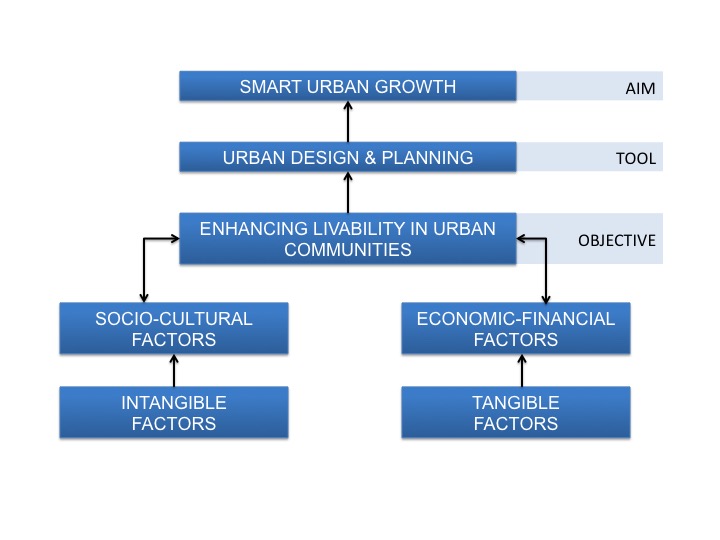 | Figure 15. Key Factors for Smart Urban Growth |
ACKNOWLEDGEMENTS
- This study was developed as part of a research project program funded from Qatar University, College of Engineering, Department of Architecture and Urban Planning. Also, the authors thank the anonymous reviewers for their comments, which contributed to an improvement of this paper.
 Abstract
Abstract Reference
Reference Full-Text PDF
Full-Text PDF Full-text HTML
Full-text HTML